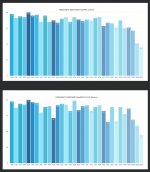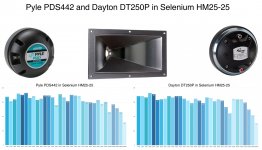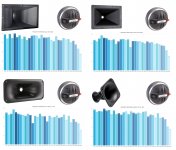They inserted the diaphragms the wrong way?
That's a bit overly dramatic .
I simply found a cleaner setup for the diaphragm seating ( in the 2 examples I briefly had ) .
FWIW, I typically expect marginal QC ( from any manufacturer ) on a $50.0 item ( when a comparable item, in the near-past was worth $300.00 ) .
- 4 decades in the biz provides that "long-view" as a side benefit .
I have been enjoying music thru my D250s on various horns for the past few weeks. Thanks to EarlK I can make them all sound pretty darn good by variying capacitors on the L-pad and using the standard Eminence 1k6 crossover. It's amazing to hear a dark sounding tweeter/horn combination suddenly brighten up.
All six horns I purchased benefit by introducing a cap (I have 1uf, 1.33uf, 2uf, 3.3uf, and 4uf all at the ready for quick comparisons). This added flexibility in tuning the sound has got me and my son thinking of different projects for all of the horns.
The horns all sound slightly different but achieve the goal of 'good sound' in my room. We got to the point where it didn't really matter which horn was used. But comparing them one after another did allow us to choose our favorites. But we both agreed we can live with any of them. I just got the aluminum Selenium HM25-25 and thought it sounded pretty good but it wasn't my favorite (a bit of a cupped sound but maybe it requires more attention at the crossover level?). I will post my opinion when things settle down and I get more listening time in. The truth is, any of these horns - even the inexpensive Goldwoods - can sound really good.
The best part of adding the capacitors was how it changed the vocals for the better. Rather than listening to a dark and chesty sound the vocals popped out and sounded more natural. In the most extreme instances cymbals went from non existent to hello, here I am, enjoy more music. It's easy to overdue it and make everything sound too bright, but finding the right balance is pretty easy.
All six horns I purchased benefit by introducing a cap (I have 1uf, 1.33uf, 2uf, 3.3uf, and 4uf all at the ready for quick comparisons). This added flexibility in tuning the sound has got me and my son thinking of different projects for all of the horns.
The horns all sound slightly different but achieve the goal of 'good sound' in my room. We got to the point where it didn't really matter which horn was used. But comparing them one after another did allow us to choose our favorites. But we both agreed we can live with any of them. I just got the aluminum Selenium HM25-25 and thought it sounded pretty good but it wasn't my favorite (a bit of a cupped sound but maybe it requires more attention at the crossover level?). I will post my opinion when things settle down and I get more listening time in. The truth is, any of these horns - even the inexpensive Goldwoods - can sound really good.
The best part of adding the capacitors was how it changed the vocals for the better. Rather than listening to a dark and chesty sound the vocals popped out and sounded more natural. In the most extreme instances cymbals went from non existent to hello, here I am, enjoy more music. It's easy to overdue it and make everything sound too bright, but finding the right balance is pretty easy.
Last edited:
Hi Earl
I decided to open up the back hoping to see what the problem is. Lifted out the diaphragm and to my horror, there were metal filings in the gap. The largest piece was about 1mm in dia, shaped like a washer.
Took about 1/2 hr to clean the gap. They were quite stubborn because being iron, they were sticking to the walls due to the magnet.
Reassembled the back and did the distortion sweeps again.
This is the earlier one with the dirty gap.

And this is with the gap cleaned.

There's a huge reduction in the 3rd harmonics.
This is with a clean gap with crossover at 950Hz/24dB.

The largest 3rd harmonic is 0.49% at about 2.8kHz.
Below is the new frequency response with a clean gap (BLUE). You were absolutely spot on about the suck out. Disappeared completely.

I decided to open up the back hoping to see what the problem is. Lifted out the diaphragm and to my horror, there were metal filings in the gap. The largest piece was about 1mm in dia, shaped like a washer.
Took about 1/2 hr to clean the gap. They were quite stubborn because being iron, they were sticking to the walls due to the magnet.
Reassembled the back and did the distortion sweeps again.
This is the earlier one with the dirty gap.

And this is with the gap cleaned.

There's a huge reduction in the 3rd harmonics.
This is with a clean gap with crossover at 950Hz/24dB.

The largest 3rd harmonic is 0.49% at about 2.8kHz.
Below is the new frequency response with a clean gap (BLUE). You were absolutely spot on about the suck out. Disappeared completely.

FWIW, I typically expect marginal QC ( from any manufacturer ) on a $50.0 item ( when a comparable item, in the near-past was worth $300.00 )
Thats a poor excuse for a crappy product
If they cant make them right for that price then they shouldnt make them at all
Other Dayton drivers are very good but this one appears to be a bit of a lemon
Time to get a speaker working.
For convenience, the D250P/H812 is placed on top of a Dayton RS180S box.

Frequency response (Red trace) with crossover set at 950Hz (HP & LP) at 24dB/oct.
Due to the offset of the acoustic centers of the D250P and the RS180S, it resulted in a notch.

This is with the D250P wired in reversed polarity.
A delay is added to the RS180S until the notch is deepest (950Hz).

Now, the D250P is re-wired back to normal phase.
No more notch in the summing. D250P and RS180S is Time-Aligned.

The D250P is finally ready for auditioning.
Will give my impressions soon.
For convenience, the D250P/H812 is placed on top of a Dayton RS180S box.

Frequency response (Red trace) with crossover set at 950Hz (HP & LP) at 24dB/oct.
Due to the offset of the acoustic centers of the D250P and the RS180S, it resulted in a notch.

This is with the D250P wired in reversed polarity.
A delay is added to the RS180S until the notch is deepest (950Hz).

Now, the D250P is re-wired back to normal phase.
No more notch in the summing. D250P and RS180S is Time-Aligned.

The D250P is finally ready for auditioning.
Will give my impressions soon.
Here's what I consider ( as a visual clue ) for the source of the high measured distortions in my 2 units.
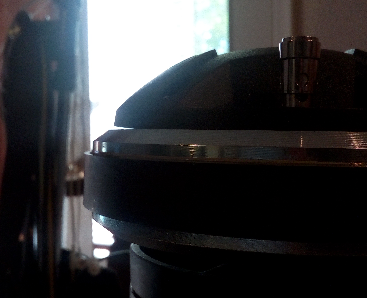
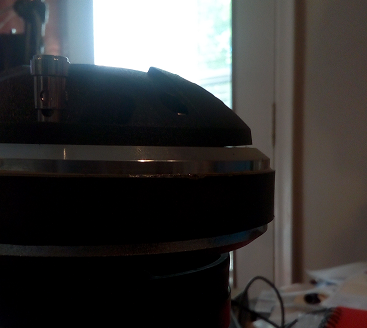
(lots of snipping)
I believe this warp-age is a manufacturing defect ( & perhaps only present on recent batches ) and as such, I'd advise anyone owning these drivers to inspect them for this same defect / and / if found, consider seeking a refund .
PS; I plan to ship both drivers back to Solen later today or tomorrow.
I have an unused pair from November 2012 and they also have the warped back cover and a significant gap.
I am guessing this flaw is either shoddy QC or part of the design.
I have an unused pair from November 2012 and they also have the warped back cover and a significant gap.
I am guessing this flaw is either shoddy QC or part of the design.
Hmmm, I was hoping the noted back-cap warpage was simply a bad run ( one-off event ) from the production line .
(FTR), compression drivers shouldn't be used ( at least professionally ) within enclosures if the ( fragile ) diaphragm is going to be exposed to significant pressures ( ie; from woofer action ).
- The "warp" did expose the diaphragm in the two examples that I had.
High levels of I.M. distortion will result from enclosure pressures.
ie; With that in mind, the warp can hardly be considered a sales feature.
>>> compression drivers shouldn't be used ( at least professionally ) within enclosures if the ( fragile ) diaphragm is going to be exposed to significant pressures ( ie; from woofer action )...
Very good point!
I'm still enjoying mine! I took the two I own apart and didn't see any 'shards' or anything else unusual. I just wiped everything clean and put them back together. Did I miss something?
I'm willing to try other compression drivers (I returned the Eminence PSD2013 because I preferred the D250-P). Maybe the Selenium 220 or 202. I looked at Radian but they are very expensive.
Very good point!
I'm still enjoying mine! I took the two I own apart and didn't see any 'shards' or anything else unusual. I just wiped everything clean and put them back together. Did I miss something?
I'm willing to try other compression drivers (I returned the Eminence PSD2013 because I preferred the D250-P). Maybe the Selenium 220 or 202. I looked at Radian but they are very expensive.
I'm willing to try other compression drivers. I looked at Radian but they are very expensive.
In stock at Parts Express $40 Tymphany Model No: DFM-2535R00-08
This 1.4 inch diaphragm 1 inch exit compression driver is for use in high quality sound reinforcement systems. The polyimide surround allows reliable operation in 2 way systems with lower crossover points. The titanium diaphragm is coated with a light, thin layer of unique damping material giving the driver an unusually smooth sound. All of the materials resist environmental factors of heat, vibration and aging ensuring many years of stable performance.
http://www.diyaudio.com/forums/multi-way/277748-your-next-compression-driver.html
I use two medium priced 1" compression drivers.
-The Faital HF108 because the plastic diaphragm generates a smooth wide bandwidth with modest 18kHz breakup. Currently crossed at 1300Hz in a SEOS-15 waveguide
-The BMS 4550 because the unique ring radiator diaphragm generates a very planar wavefront launch which is important for conical horns like the Synergy.
I bought the B&C DE250 and compared it to the Dayton D250P. They are physically similar. The Dayton's back cap is plastic and doesn't perfectly cover the element inside which exposes it to backwave pressure from the woofer. The B&C's back cover is metal and fits perfectly. For my testing, the drivers sat on top of the cabinet uneffected by the backwave.
Subjectively, the B&C has a more liquid sound, the Dayton is dryer and more garbled.
Here are my in room measurements. I used the very nice looking FaitalPRO LTH102 horn. Clearly, the drivers don't measure the same.
Subjectively, the B&C has a more liquid sound, the Dayton is dryer and more garbled.
Here are my in room measurements. I used the very nice looking FaitalPRO LTH102 horn. Clearly, the drivers don't measure the same.
Attachments
The B&C also measures flatter and is more efficient in the H812.
I've concluded the B&C is a different and better sounding driver than the Dayton "clone". In the days ahead I'll post the charts for the various horns I bought.
Thanks to everyone who came along for the ride!
I've concluded the B&C is a different and better sounding driver than the Dayton "clone". In the days ahead I'll post the charts for the various horns I bought.
Thanks to everyone who came along for the ride!
Pyle PDS442 and Dayton DT250P in Selenium HR25-25. These are both good budget drivers to cross over at 1600Hz. I haven't seen any measurements on the Pyle PDS442 so I thought I'd post mine. It sounds better than it's low price suggests. Neither of these drivers produce much sibilance. Neither is better - they both sound good. Maybe the Pyle sounds a bit more colorful.
Attachments
- Status
- This old topic is closed. If you want to reopen this topic, contact a moderator using the "Report Post" button.
- Home
- Loudspeakers
- Multi-Way
- Dayton DT250P-8 compression tweeter sings
